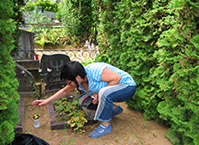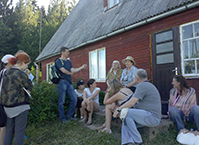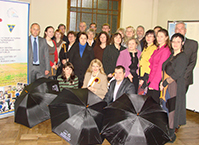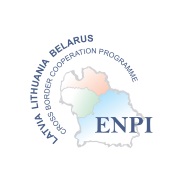About Dansk settlement
Categories: Residence and weekdays, Anita Locmele
Story-teller: “We know, that Latgalians also were the raiders, and they needed that, I don’t know, slaves or what, or maybe there were a lot of deaths during some periods of diseases, I don’t know. There, we say – Puncuļova hill fort, though officially it is Ābelene hill fort, I don’t know if it is Ābelene, for us it is Puncuļova hill fort. And they, it is said, the landlords of that hill fort also organized attacks or participated in some common attack, and they got captives from the Don region for themselves. And they put them up in the territory of our Danska village and made them clear woodland, cut trees, cultivate the land, and thus we are named – danski, danski, let’s go to Danskeji. So, so, that is that village, there is such a guess, that it might have originated from that. That is because some of us, villagers, have darker skin colour, so to say, we are a bit different, maybe we really are.
Interviewer: “Your character must be more passionate.”
Story-teller: “Maybe, maybe. The peculiarity of Danska village is that the men of our village do not look for wives from remote places, but rather marry the girls from their village. There were many houses, and they married from their own village. That’s why there is only one surname in our village – Mežals. If there is any other, then it has just appeared. Another surname is Ločmels, they are from the neighbouring village, from Puncuļova. It is like this. There were a lot of people indeed. Just yesterday I received, I was shown where the old place of the village was, where and on which side the road was.”
Interviewer: “Before going to live in individual farms?”
Story-teller: “What did you say?”
Interviewer: “Was that so before going to live in individual farms?”
Story-teller: “I think, yes! Being a child I didn’t really listen to, and a lot was spoken. My grandfather told me, that when he was trying to escape from, I don’t know, maybe the Tsar’s army, or some others who were chasing, he wanted to stay at home, but he was taken away. A lot of stories were told, it was interesting. They showed where our former house was, I mean, my grandfather’s family house. Then people moved to individual farms, yes. There were thirty-eight houses recently, now there are only four houses, where people live. It felt sad when I collected the old place-names, it was very sad to conclude that only the foundations of houses were left, or, people die out, die out, leave for, as we say, for Čuiļeja, move there. In my childhood, there was an important event, it was said that on a certain day one family, the so-called Kūraļi, moved to Čuiļeja. And I got to the attic to see them leaving. All my playmates, as we say, all their belongings were loaded in such a truck, and they left, so it was.”
Images
Audio
Researcher: Dr. philol. Gatis Ozoliņš, Daugavpils Universitāte











